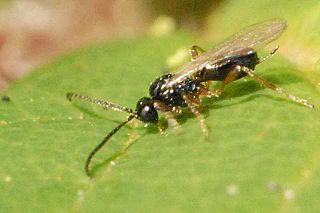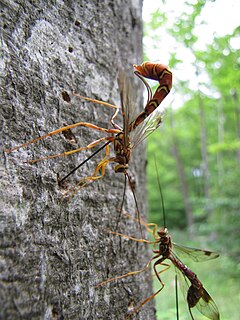
The Braconidae are a family of parasitoid wasps. After the closely related Ichneumonidae, braconids make up the second-largest family in the order Hymenoptera, with about 17,000 recognized species and many thousands more undescribed. One analysis estimated a total between 30,000 and 50,000, and another provided a narrower estimate between 42,000 and 43,000 species.

The Aphidiinae are a subfamily of tiny parasitoid wasps that use aphids as their hosts. Several species have been used in biological control programs of various aphids.

Microgastrinae is a subfamily of braconid wasps, encompassing 2,000 described species, with an estimated 5,000-10,000 total species. This makes it one of the most species rich subfamilies of parasitoid wasps.

Agathidinae is a subfamily of braconid parasitoid wasps. Some species have been used in biological control programs.

The Doryctinae or doryctine wasps are a large subfamily of braconid parasitic wasps (Braconidae). Numerous genera and species formerly unknown to science are being described every year. This subfamily is presumably part of a clade containing otherwise any or all of the Alysiinae, Braconinae, Gnamptodontinae, Opiinae and Ypsistocerinae, and might be most closely related to the last one of these; whether the Rogadinae are also part of this group is not known some Doryctinae are known to form galls on plantswith certainty.
Meteorus is a genus of parasitoid wasps in the family Braconidae. It comprises over 330 species worldwide.

Bracon is a genus of wasps in the Braconidae, a family of parasitoid wasps. There are several hundred described species but there are thousands still undescribed. The genus is cosmopolitan, distributed throughout the world, with most of the described species occurring in the Palearctic ecozone.

The Braconinae are a large subfamily of braconid parasitoid wasps with more than 2,000 described species. Many species, including Bracon brevicornis, have been used in biocontrol programs.

The Opiinae are a subfamily of braconid parasitoid wasps with over 1300 described species. Several species have been used in biocontrol programs against fruit flies and Agromyzidae flies. They are closely related to the Alysiinae.

The Rogadinae are a large subfamily of braconid parasitoid wasps. Several Rogadinae species parasitize pest caterpillars and are important for naturally occurring biological control.
AdeliiniViereck, 1918 is a tribe of braconid parasitoid wasps within the subfamily Cheloninae. Until 2016, Adeliini was classified as a separate subfamily, the Adeliinae. However, the name Adeliini Kirby, 1828 for a tribe of beetles has priority, and Adeliini Viereck, 1918 is a junior homonym.

The Cenocoeliinae are a subfamily of braconid parasitoid wasps.
Apozyx is a genus of braconid parasitic wasps with only one species, Apozyx penyai. It is the only genus in the subfamily Apozyginae. This subfamily was originally proposed as a separate family by Mason in 1978.
The Cardiochilinae are a subfamily of braconid parasitoid wasps. This subfamily has been treated as a tribe of Microgastrinae in the past. Some species including Toxoneuron nigriceps have been used in biocontrol programs.
Dirrhope is the only extant genus in the subfamily Dirrhopinae of braconid parasitoid wasps. Dirrope was included in the Microgastrinae until 1984. Specimens of this genus have been found fossilsed in amber dating from the Cretaceous period.
Aerophilus is a genus of parasitoid wasps belonging to the family Braconidae. As members of the subfamily Agathidinae, they are koinobiont endoparasitoids of caterpillars. The host is attacked as an early instar, but not consumed and killed until the host is about to pupate. Nearly all species of Aerophilus have a narrow host range, attacking only one caterpillar species. However, the host range of the genus as a whole is quite broad, including many families of Lepidoptera.

Blacini is a tribe of braconid Parasitoid wasps. Formerly the subfamily Blacinae, this group was demoted to a tribe and placed within the Brachistinae based on molecular evidence in 2011.
The Ichneutinae are a subfamily of braconid parasitoid wasps.

Brachistinae is a subfamily of braconid wasps in the family Braconidae.













